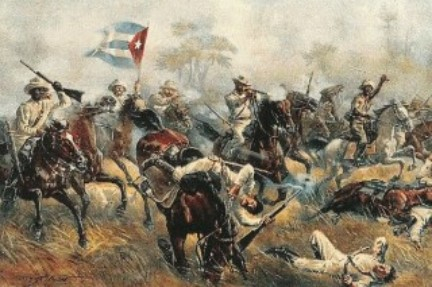 At dawn on July 13, 1895, at the plains of Peralejo, 10 miles from the historic city of Bayamo, General Antonio Maceo deployed his forces to do battle with Spain’s Captain General of Cuba, Arsenio Martínez Campos.
At dawn on July 13, 1895, at the plains of Peralejo, 10 miles from the historic city of Bayamo, General Antonio Maceo deployed his forces to do battle with Spain’s Captain General of Cuba, Arsenio Martínez Campos.
The Captain General departed from the port of Manzanillo, and soon was joined by General Fidel Alonso de Santocildes’ column, bringing the Spanish army to 1500 men. Martínez Campos had ordered two additional columns from Santiago and Tunas to march into the Bayamo region, to annihilate Maceo’s forces with the powerful punch of over 5000 soldiers and crush the rebellion in Oriente.
Maceo assembled nearly 1000 men in Peralejo to prevent the joining of the marching columns from Santiago and Tunas with Martínez Campos’ forces. The Cuban infantry had prepared a defense in depth along the road approaching Bayamo. Maceo kept his veteran cavalry in the rear area as a powerful reserve. It was a well-prepared position to decimate the Spanish with a fusillade and a cavalry charge.
But the Spaniards got hold of the awaiting ambush and changed direction. General Santocildes appeared behind the Cuban lines, defended by general Alfonso Goulet, who with his 40 men delayed the Spanish attack, allowing General Maceo to re-deployed his forces. General Goulet fought and died as a hero of Cuban independence.
Maceo, who was in command of the cavalry, immediately realized the danger and ordered a swift “Machete’s charge” against the advancing Spaniards, engulfed in a ferocious fight with general Goulet small detachment.
Here was the Cuban hero at his best, proving once more his tactical genius and leadership. Maceo was pure courage with a brilliant mind. His rapid response overcame a dangerous attack, as he swiftly directed difficult maneuvers with precise instructions until his forces encircled Campos’ column.
Spanish newspaper correspondent Andres Ollero reported on the battle at Peralejo: “Our soldiers in fact, were soon attacked from every direction, and Gen. Santocildes, at the head of his column, broke the enemy’s lines several times and advanced, only to be encircled again. Both the Spaniards and the Cubans fought with fearless tenacity, in the midst Santocildes was killed.”
According to eyewitnesses, Gen. Campos remained calm and in control of his beleaguered troops, he gathered his forces in hollow squares, using wagons for protective breastwork, and he personally directed the defenses. The fierce fight lasted more than four hours until the rebels began running out of ammunition. Late in the afternoon, the Spaniards broke through the Cuban encirclement and reached the safety of Bayamo’s forts, which the captain general entered in shock and disbelief.
For Martínez Campos, Peralejo was a near catastrophe. For Maceo it was one of his most brilliant battles.
Peralejo was the first major battle of the War of Independence (1895-1898). The Cuban victory had an immediate strategic impact in the Spanish army deployment of its battalions in Oriente. In essence, the colonial forces reinforced the urban areas and the Cuban rebels established permanent bases of operations in the rugged forests and mountains of Oriente. Three months later (October 22, 1895) at the “Mangos de Baraguá,” Antonio Maceo began the historical invasion of the Western provinces.
* Pedro Roig is Executive Director of the Cuban Studies Institute. Roig is an attorney and historian that has written several books, including the Death of a Dream: A History of Cuba. He is a veteran of the Brigade 2506.









